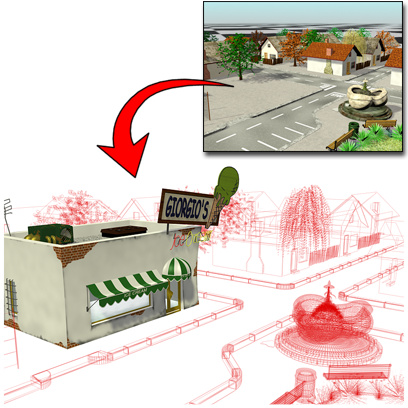An externally referenced scene, or XRef scene, appears in your current file, but is actually loaded temporarily from another MAX file. As a result, the source scene is protected from any modifications you might make to the XRef scene via the main scene. Updates or changes made to the source scenes are also updated in the main file once the changes are made and saved to the source file.
XRef scenes allow a team working on the same project to have access to each other’s work without the risk of changing the files. A designer can model a building, a second modeler might create the landscape; or one modeler might create a setting while another modeler creates a character. The animator can externally reference the setting as a scene and animate the cameras or characters in the setting without being able to make changes to the setting. If the setting file is changed, those changes will be reflected in the animator’s scene.
Objects loaded in the main file via XRef scenes cannot be selected nor modified, and do not appear in the Select From Scene dialog or Scene Explorer, the modifier stack, or the Track View. You can animate them in the current file only by using the Bind To Parent function in the XRef Scenes window.
You can snap to externally referenced scene entities. You can use Snap, AutoGrid, and Clone and Align to position local objects in context, as well as to pick objects as the target location for the clones. If you need to move, rotate or scale the referenced scene, you can bind it to a local object. Transforming the object the externally referenced scene was bound to transforms all objects in the externally referenced scene. You can also use externally referenced objects in the scene as the reference coordinate system. When you save changes to the externally referenced file (such as objects added, edited, or deleted), updating the XRef Scene inherits those changes locally.

Importing the whole village model into the building model as an XRef
Radiosity solution data cannot be part of an XRef if objects have duplicate names. To solve this, change the duplicate names. Also, to reference radiosity data externally, the Save Scene Information In MAX File switch must be on in the Radiosity panel of the Preferences dialog. (It is on by default.)
Be aware that render effects are not carried into the main scene by XRef scenes. To use the render effects (such as glow or flare) from the XRef file, merge them in using the Merge buttons found in the Environment And Effects dialog.
Choosing XRef Scene displays the XRef Scenes dialog.
Accessing XRef Scenes
Although XRefs are inaccessible “boxes” in the scene, they can be accessed in various ways.
- Cameras and lights in the XRef scenes can be accessed in the Viewports list and assigned to viewports in the current scene.
- Objects from the XRef scenes are included in the Summary Info dialog.
- Objects can be snapped to or used for alignment purposes with AutoGrid and Align.
- AutoGrid works on XRef scene objects.
- You can use objects from XRef scenes as target for cloning or reference systems.
Nesting XRef Scenes
XRef scenes can be nested. That is, an XRef scene can contain other XRef scenes, which can in turn contain other XRef scenes.
For more about nesting XRef scenes, see the "XRef Scene Overlays" page.